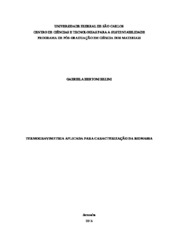| dc.contributor.author | Belini, Gabriela Bertoni | |
| dc.date.accessioned | 2018-05-03T12:47:43Z | |
| dc.date.available | 2018-05-03T12:47:43Z | |
| dc.date.issued | 2018-03-02 | |
| dc.identifier.citation | BELINI, Gabriela Bertoni. Termogravimetria aplicada para caracterização da biomassa. 2018. Dissertação (Mestrado em Ciência dos Materiais) – Universidade Federal de São Carlos, Sorocaba, 2018. Disponível em: https://repositorio.ufscar.br/handle/ufscar/9855. | * |
| dc.identifier.uri | https://repositorio.ufscar.br/handle/ufscar/9855 | |
| dc.description.abstract | Issues related to renewable energy have been increasingly addressed and discussed. In this
context, biomass is an alternative for the generation of renewable and available energy. Its
use, instead of fossil fuels, helps to reduce the environmental impact and the greenhouse
effect. The aim of this study was to verify the influence of biomass components on their
thermal degradation using thermogravimetry and to compare values for proximate analysis
and for a heating schedule. The materials used were pine (Pinus elliottii) and eucalyptus
(Eucalyptus Grandis x Eucalyptus Urophylla) woods and sugarcane bagasse (Saccharum
officinarum). The raw materials were analyzed in 4 different treatments: in natura, material
without extractives, holocellulose and lignin. The thermogravimetric analyzes were performed
on the Perkin Elmer TGA device Pyris 1 TGA. The analyzes were carried out under a
nitrogen atmosphere with a flow of 20 ml.min-1. The heating rate was 20 ° C.min-1 starting at
50 ° C to 900 ° C. Proximate analysis of the biomasses, the chemical composition of the
materials and the high heating value (HHV) with and without extractives were calculated. It
was observed that the presence of the extractives decreases the temperature of the beginning
of the thermal degradation, and they are the first ones to be volatilized, besides diminishing
the HHV. From the separated components of the biomass, it was observed that the polyses
and cellulose, which composes holocellulose, begin their degradation before lignin, which
presented a higher degradation temperature and a higher thermal stability. | eng |
| dc.description.sponsorship | Coordenação de Aperfeiçoamento de Pessoal de Nível Superior (CAPES) | por |
| dc.language.iso | por | por |
| dc.publisher | Universidade Federal de São Carlos | por |
| dc.rights.uri | Acesso aberto | por |
| dc.subject | Composição química | por |
| dc.subject | Degradação térmica | por |
| dc.subject | Bioenergia | por |
| dc.subject | Chemical composition | eng |
| dc.subject | Thermal degradation | eng |
| dc.subject | Bioenergy | eng |
| dc.subject | Thermogravimetry | eng |
| dc.subject | Biocombustíveis | por |
| dc.subject | Biomass energy | eng |
| dc.title | Termogravimetria aplicada para caracterização da biomassa | por |
| dc.title.alternative | Thermogravimetry applied for biomass characterization | eng |
| dc.type | Dissertação | por |
| dc.contributor.advisor1 | Yamaji, Fábio Minoru | |
| dc.contributor.advisor1Lattes | http://lattes.cnpq.br/4787449634914831 | por |
| dc.contributor.advisor-co1 | Varanda, Luciano Donizeti | |
| dc.contributor.advisor-co1Lattes | http://lattes.cnpq.br/9095009636880827 | por |
| dc.description.resumo | Temas relacionados às energias renováveis têm sido cada vez mais abordados e discutidos.
Neste contexto, a biomassa surge como alternativa para a geração de energia renovável e
disponível. Sua utilização, no lugar dos combustíveis fósseis, auxilia na redução do impacto
ambiental e do efeito estufa. O objetivo do trabalho foi verificar a influência dos componentes
da biomassa na sua degradação térmica utilizando a termogravimetria e comparar valores para
análise imediata e por uma programação de aquecimento. Os materiais utilizados foram
madeiras de pinus (Pinus elliottii) e eucalipto (Eucalyptus Grandis x Eucalyptus Urophylla) e
bagaço de cana-de-açúcar (Saccharum officinarum). As matérias-primas foram analisadas em
4 diferentes tratamentos: in natura, material sem extrativos, holocelulose e lignina. As
análises termogravimétricas foram feitas no equipamento TGA Perkin Elmer modelo Pyris 1
TGA. As análises foram realizadas em atmosfera de nitrogênio com um fluxo de 20 ml.min-1.
A razão de aquecimento foi de 20 °C.min-1 partindo de 50 °C até 900 °C. Foram feitas análise
imediata das biomassas, a composição química dos materiais e o poder calorífico superior
(PCS) com e sem extrativos. Observou-se que a presença dos extrativos diminui a temperatura
de início da degradação térmica, e são os primeiros a serem volatilizados, além de diminuírem
o PCS. A partir dos componentes separados da biomassa observou-se que as polioses e
celulose, que compõe a holocelulose, iniciam sua degradação antes da lignina, que apresentou
uma maior temperatura de degradação e uma maior estabilidade térmica. | por |
| dc.publisher.initials | UFSCar | por |
| dc.publisher.program | Programa de Pós-Graduação em Ciência dos Materiais - PPGCM-So | por |
| dc.subject.cnpq | ENGENHARIAS::ENGENHARIA DE MATERIAIS E METALURGICA::MATERIAIS NAO METALICOS::POLIMEROS, APLICACOES | por |
| dc.description.sponsorshipId | 33526474885 | por |
| dc.ufscar.embargo | Online | por |
| dc.publisher.address | Câmpus Sorocaba | por |
| dc.contributor.authorlattes | http://lattes.cnpq.br/1833991005624421 | por |
